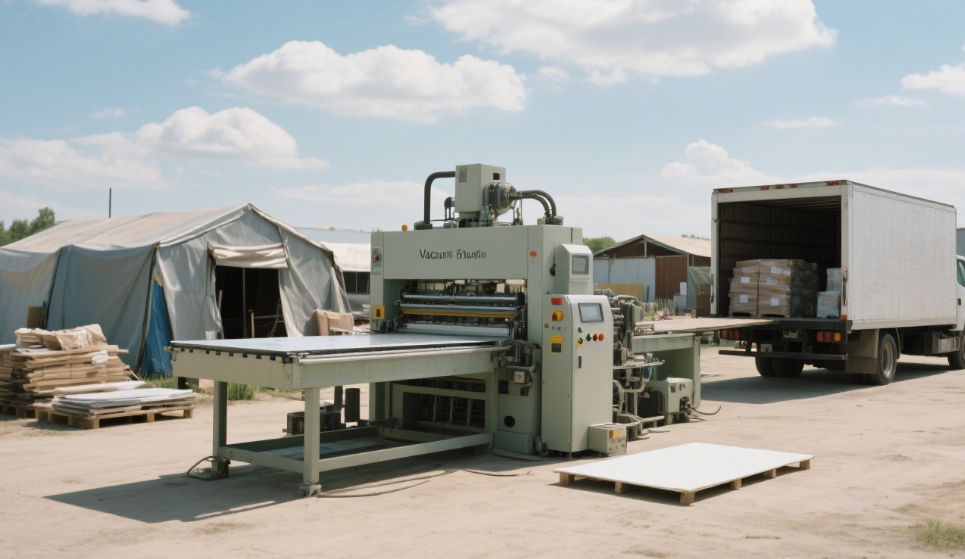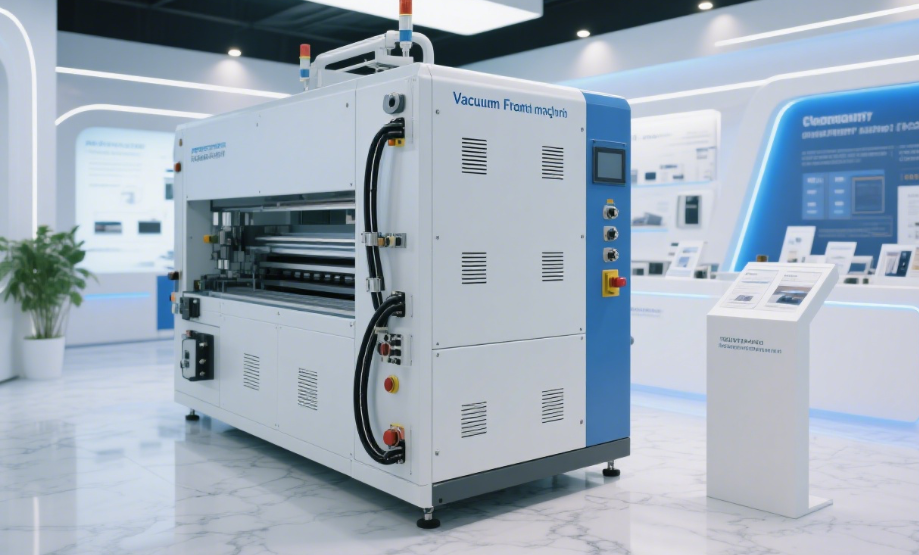Views: 0 Author: Site Editor Publish Time: 2025-07-08 Origin: Site
In today’s competitive manufacturing landscape, packaging is no longer merely a means to contain and transport goods. Packaging now plays a vital role in protecting products, maintaining their quality, ensuring safety, and enhancing the consumer experience. As industries evolve, the demand for efficient and cost-effective packaging solutions has led to the rise of innovative technologies, one of the most notable being vacuum forming.
Vacuum forming machines are widely used in the packaging industry to create customized, durable, and high-quality packaging products. This technology has revolutionized how packaging is made, providing manufacturers with the flexibility, precision, and efficiency needed to meet modern market demands.
In this post, we will explore the key applications of vacuum forming machines in the packaging industry. You’ll learn how these machines are applied across various sectors, from food and medical packaging to consumer goods and electronics. By the end of this article, you will have a comprehensive understanding of the many advantages vacuum forming offers in packaging, and how businesses can leverage this technology to stay ahead in the market.
A vacuum forming machine is a type of thermoforming machine used to shape a sheet of thermoplastic material into a specific shape or mold. The process involves heating the plastic sheet until it becomes pliable and then using vacuum pressure to pull the sheet into the mold, creating a detailed and accurate product.
Unlike injection molding, which requires complex molds for each production run, vacuum forming uses a single mold for each part, making it a more cost-effective solution, especially for smaller production volumes. The process is quick, versatile, and allows for customization, making it an ideal choice for creating packaging solutions.
Precision: Vacuum forming machines are capable of achieving high precision, which is essential for creating detailed and accurate packaging designs. The technology ensures that every mold is consistently replicated, delivering high-quality packaging each time.
Speed: Vacuum forming offers faster production cycles compared to other manufacturing processes, allowing manufacturers to quickly adapt to market demands and reduce turnaround times.
Cost-Effectiveness: With lower tooling costs compared to injection molding, vacuum forming is a more affordable option for both small and large-scale production runs, making it particularly attractive for businesses with varying production needs.
Material Flexibility: Vacuum forming machines can process a wide range of materials, including PVC, PETG, polystyrene, acrylic, and more, providing manufacturers with the flexibility to choose the best material for each application.

Vacuum forming has established itself as an essential technology in the packaging industry. Its versatility and affordability make it an ideal solution for creating various types of packaging products. Let’s explore how vacuum forming is applied in different sectors.
In the food industry, packaging is crucial for maintaining the freshness, quality, and safety of products. Vacuum forming machines play a significant role in creating packaging that preserves food items while offering excellent visibility for consumers.
Blister Packaging: Vacuum-formed blister packs are widely used for packaging small food items, such as candies, chocolates, and nuts. These clear plastic packs allow consumers to view the product while ensuring it is securely sealed and protected from external elements.
Containers for Fresh Produce: For fresh items like fruits, vegetables, sandwiches, and salads, vacuum-formed containers provide an airtight seal that prevents contamination and extends shelf life. The packaging also helps maintain product integrity during transport, reducing damage.
Meat and Fish Packaging: Vacuum-forming technology is used extensively in packaging fresh meat, fish, and poultry. The vacuum-sealed packaging preserves the freshness of the product and prevents spoilage, extending the shelf life and keeping the product safe during transport.
The medical industry demands packaging solutions that are not only protective but also meet stringent hygiene standards. Vacuum forming machines are ideal for producing medical packaging that ensures the safety and sterility of medical devices and pharmaceuticals.
Sterile Packaging for Medical Devices: Vacuum-formed packaging is widely used for medical instruments such as syringes, catheters, and surgical tools. The airtight, tamper-proof seal ensures that these products remain sterile until they are used.
Pharmaceutical Packaging: Blister packs, often used for pharmaceuticals, are commonly produced using vacuum forming. These packs securely hold tablets and capsules, keeping them safe from moisture, air, and other contaminants.
Protective Casings for Medical Equipment: Vacuum forming is also used to create durable protective casings for sensitive medical equipment, ensuring that devices are shielded from damage during transport and storage.
Vacuum forming is commonly used in the packaging of consumer goods, offering a perfect balance between durability, cost-effectiveness, and presentation. Manufacturers rely on vacuum forming to create packaging that not only protects but also enhances the visual appeal of products.
Electronics and Toys Packaging: Vacuum-forming machines are often used to package delicate electronics like mobile phones, tablets, and televisions. The packaging ensures that the products are securely held in place, minimizing the risk of damage during transport. Additionally, vacuum-formed packaging for toys provides protection while allowing consumers to see the product clearly through transparent plastic.
Point of Sale Displays: Packaging isn’t limited to the product itself. Vacuum forming is also used to produce display trays, stands, and holders for retail environments. These eye-catching displays help products stand out on store shelves, enhancing brand visibility and boosting sales.
Packaging for Home Goods: Household items such as kitchen appliances, cleaning products, and gardening tools are often packaged using vacuum-formed plastic. The durable packaging ensures that the products remain intact during handling and shipping, while also providing an attractive design for consumers.
Vacuum forming machines offer several key advantages that make them a valuable tool for manufacturers across various sectors. Below are some of the most important benefits:
One of the most significant advantages of vacuum forming is its speed. Once the mold is created, the process of heating the plastic, applying the vacuum, and cooling the material takes only a few minutes, allowing manufacturers to quickly produce large quantities of packaging products.
Vacuum forming is a more affordable option for low- to medium-volume production runs compared to injection molding. The tooling costs are lower, and the process requires fewer resources to create molds, making it an ideal choice for businesses looking to minimize production costs.
With vacuum forming, manufacturers have the ability to produce packaging that is tailored to the specific needs of the product. The molds can be easily adjusted to accommodate different shapes and sizes, making it easier to create custom packaging solutions. Additionally, the flexibility of the process allows for rapid prototyping and testing of new designs.
Vacuum forming can work with a variety of thermoplastic materials, each offering unique properties that can benefit different types of packaging. For instance, acrylic is often used for its clarity and strength, while PETG is a popular choice for food packaging due to its ability to preserve freshness.
As consumer awareness about environmental sustainability grows, businesses are seeking packaging solutions that are eco-friendly. Vacuum-forming machines allow for the use of recyclable materials, which helps reduce waste and environmental impact. This is an important consideration for companies looking to meet sustainability goals.
While vacuum forming offers numerous benefits, it also has its challenges. Manufacturers should be aware of the following limitations:
Vacuum forming works well for shallow to moderately deep molds, but it may struggle with deep draws or intricate designs. Products with deep contours or detailed features may require additional techniques, such as plug assists, to achieve the desired shape.
Because vacuum forming relies on stretching the plastic over the mold, it can result in uneven wall thickness. Areas of the packaging that are deeper or more intricate may have thinner plastic, which could affect the strength and durability of the packaging.
While vacuum forming is generally more affordable than other molding methods, highly complex molds can still be expensive to produce. Intricate designs that require advanced tooling may increase production costs, which can be a consideration for businesses with limited budgets.

The packaging industry is evolving rapidly, and vacuum forming technology is keeping pace with these changes. Here are some of the emerging trends that will shape the future of vacuum forming:
The integration of 3D printing with vacuum forming is revolutionizing packaging design. 3D printing allows manufacturers to quickly create detailed molds, which can then be used in the vacuum forming process to produce prototypes or short production runs. This combination reduces the time and cost involved in product development.
As the demand for smart packaging grows, vacuum-forming machines are evolving to meet this need. Smart packaging involves incorporating technology such as sensors, RFID tags, or QR codes into packaging to provide real-time data about the product’s condition during transport or storage. Vacuum forming machines are increasingly used to create packaging that integrates these features.
The push toward sustainability is a key driver of innovation in vacuum forming. New biodegradable and recyclable materials are being developed for use in the vacuum-forming process, offering manufacturers more environmentally friendly packaging options. As sustainability becomes a priority for businesses and consumers alike, vacuum forming machines will continue to play a vital role in producing eco-friendly packaging.
Vacuum forming machines have become an essential technology in the packaging industry, offering a range of benefits that help businesses meet the demands of today’s competitive market. From food and medical packaging to consumer goods and electronics, vacuum forming provides a cost-effective, flexible, and efficient solution for creating high-quality packaging.
As industries continue to prioritize sustainability, speed, and customization, vacuum forming machines will remain at the forefront of packaging innovation. Wenzhou Mingdu Machinery provides top-of-the-line vacuum forming machines designed to meet the needs of manufacturers across various sectors. With their reliability, efficiency, and cost-effectiveness, Mingdu’s vacuum forming machines can help you achieve the packaging solutions your business needs to thrive.
A: A vacuum forming machine works by heating a plastic sheet until it becomes pliable. The sheet is then placed over a mold, and a vacuum is applied to pull the plastic tightly over the mold, shaping it into the desired form.
A: Vacuum forming machines can work with a variety of thermoplastics, including PVC, PETG, ABS, acrylic, and more, depending on the specific requirements of the packaging.
A: Vacuum forming is cost-effective, faster, and more flexible than injection molding, making it ideal for small to medium production runs and custom packaging solutions.
A: Yes, vacuum forming is widely used in food packaging for products like blister packs, sandwich containers, and produce trays, providing protection and freshness for food items.
A: Yes, vacuum forming is ideal for creating sterile, protective packaging for medical devices, pharmaceuticals, and other healthcare products, ensuring safety and compliance with industry standards.
content is empty!